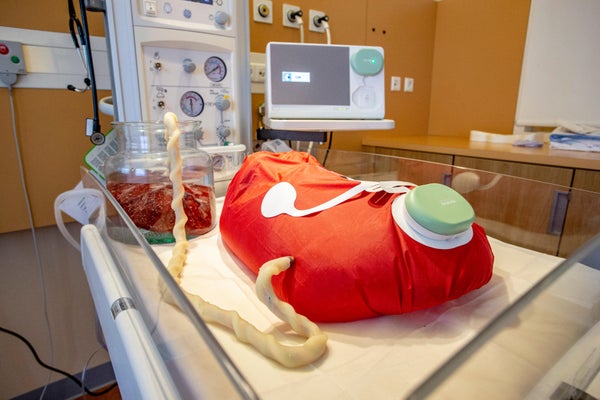Artificial wombs are moving from the realm of science fiction to possible trials with severely premature human babies. We are excited about the great potential benefits of this technology; however, with fetal rights now a political front in the abortion debate, we believe that society must address the ethical and legal implications well before those clinical trials begin.
Globally, preterm birth is the leading cause of death in children under age five. An artificial womb could provide severely premature newborns with an environment like the uterus by suspending the fetus in a flexible container filled with lab-made amniotic fluid. This innovation—so far tested only in animals—might mitigate or even prevent complications of prematurity by allowing the fetus’s underdeveloped heart and lungs to continue to grow.
An advisory panel of the U.S Food and Drug Administration is now considering whether to permit those first in-human clinical trials, despite only limited success in animal trials. Currently, from a bioethical perspective, it is not clear that animal models provide enough evidence to move forward with human trials. However, if the technology proves safe and effective someday, it could be a game-changer. If that happens, what are the ethical and legal issues that we worry about?
On supporting science journalism
If you're enjoying this article, consider supporting our award-winning journalism by subscribing. By purchasing a subscription you are helping to ensure the future of impactful stories about the discoveries and ideas shaping our world today.
For the benefits of artificial wombs to outweigh the risks, they must be available to fetuses who often do not thrive using current technology—incubators, bilirubin lights and oxygen, among other things. Fetuses at more than 23 weeks of gestation tend to do well under current technology. But fetuses less than 23 weeks do not. The decision to use an artificial womb would put enormous pressure on expecting parents who will have very little time to make agonizing decisions about trial participation, to the point of substantially compromising their ability to consent with a full understanding of the risks of participation.
Decision-making at the borderline of fetal “viability” is already ethically and clinically complex, as clinicians and expecting parents weigh various potential outcomes. Viability is a moving target, where outcomes are nearly impossible to predict, with or without this novel technology. Without clear regulatory protection of parental autonomy in making these decisions, and better animal studies delineating potential benefits, artificial wombs could exacerbate an already fraught landscape, by pressuring and constraining expecting parents’ decision-making.
Underlying these concerns is the ever-present value-based debate regarding the moral status of a fetus and attempts at reaching a “scientific” determination of when a fetus achieves “full” moral status or even personhood. In this intricate context, people may reasonably disagree. Most national medical societies strongly encourage leaving to pregnant people and their medical teams decisions regarding termination, mode of delivery and parameters of resuscitation. If artificial wombs encourage restrictive regulation that limits the decision-making of parents and clinicians, serious ethical concerns will arise.
Next, the technology will expose pregnant people to extensive risk, with—at this time—only hypothetical benefits for their fetuses. Most current iterations of the technology require a cesarean section, one that is much riskier at earlier stages in pregnancy than a typical cesarean and may compromise future fertility. Achieving truly informed consent given all these pressures and complexities at a literal do-or-die moment in childbearing could be impossible.
Moreover, what happens if a pregnant person declines this option? Artificial wombs could be used in ways that limit reproductive freedoms. Leaders in the antiabortion movement have already advocated for cesarean sections—even over pregnant patients’ objections—to optimize the outcomes for the baby. In a political climate where reproductive rights are being curtailed in the name of protecting fetuses, safe and effective artificial wombs could be used to argue that the fetus not only has a right to live, but also has the right to any and all medical care available. Such an argument could promote legislation that requires dangerous surgery despite a patient’s objection. With current legislation that defines personhood in various states, this is a real possibility.
From a perspective of reproductive justice, this technology is unlikely to be equitably available. While the global mortality rate for children under five continues to fall worldwide, children in sub-Saharan Africa still have the highest rate of mortality in the world, at 74 deaths per 1,000 live births—14 times higher than in Europe and North America. Many of these deaths are linked to prematurity. It is unlikely that clinical trials with artificial wombs, much less their use in clinical practice, would be available where they are needed the most.
Finally, looking into the distant future, questions arise about the possibility of using artificial wombs early in the pregnancy. Most researchers currently think that using this technology in the early first trimester, when most abortions occur, would be impossible. Yet science is ever innovative, and one can imagine a dystopian future in which it may be possible to say to a pregnant person: If you do not wish to carry this pregnancy any longer, we can separate you from the fetus and transfer it into an artificial womb.
What would such a scenario mean for prospective parents? Would they still be considered legal parents of the entity in the artificial womb? Or would there be a presumption in favor of adoption? Would artificial wombs make both genetic parents equal decision-makers, since the fetus is not within the body of only one of them? Or would both lose their authority, leaving decision-making in the hands of regulators? How would current clinical norms surrounding decision-making for premature newborns translate to this context?
While artificial wombs show promise, moving forward to the first in-human trials—in the absence of clear evidence of possible benefit—involves great risks of curtailing the reproductive rights of prospective parents.
This is an opinion and analysis article, and the views expressed by the author or authors are not necessarily those of Scientific American.
